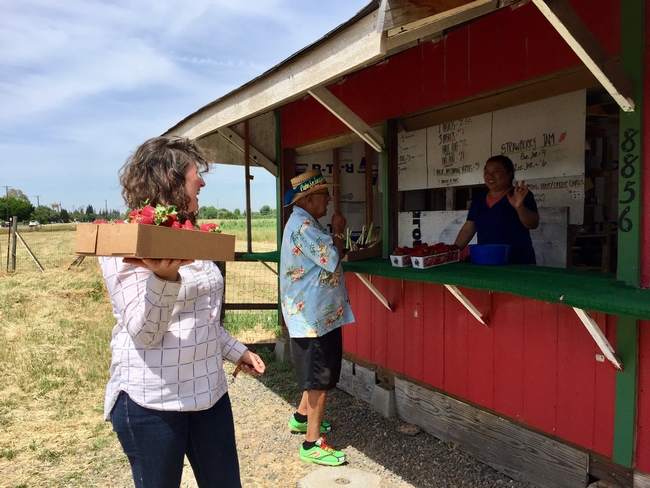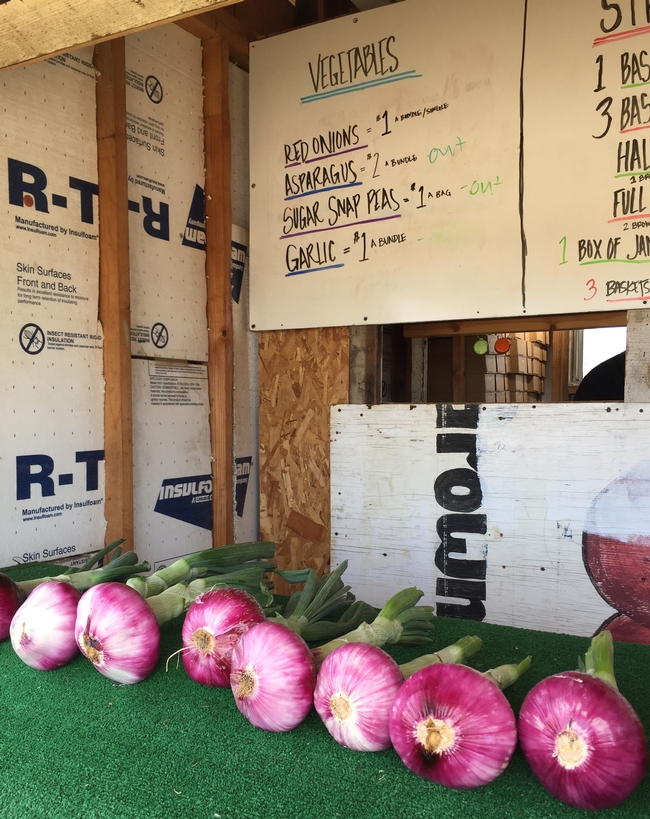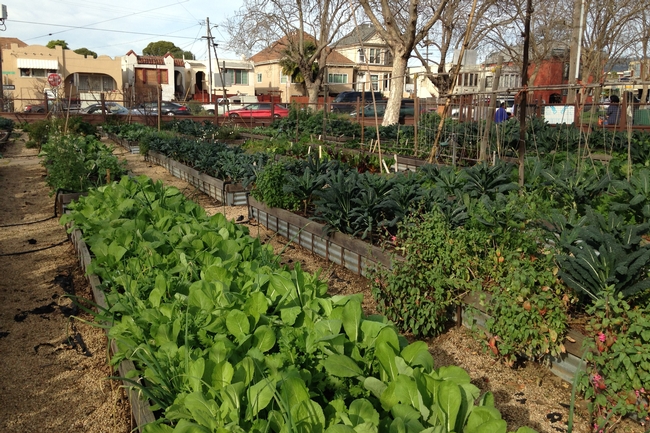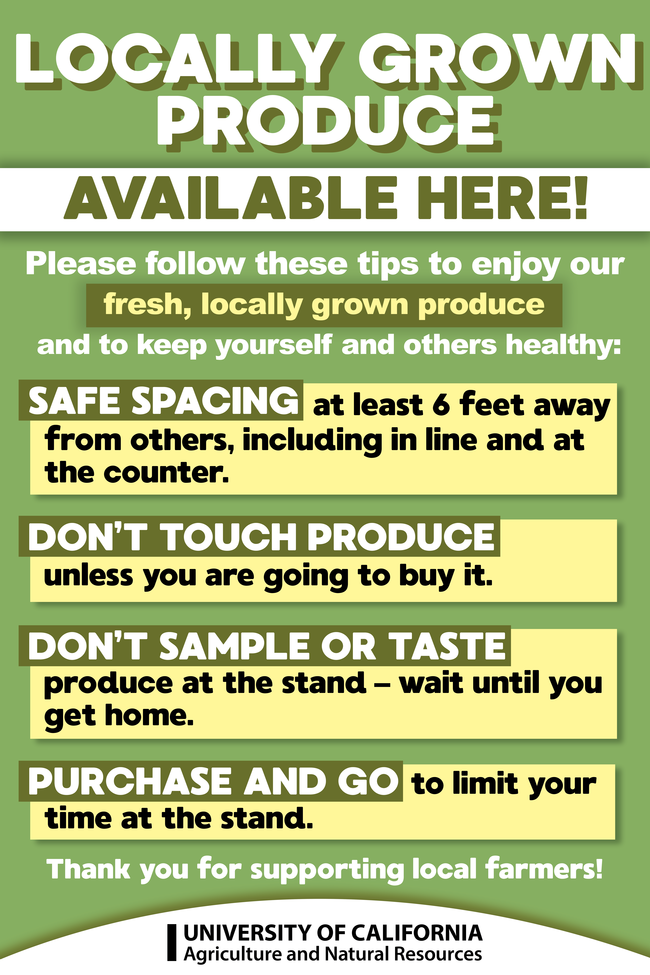
Posts Tagged: Rachel Surls
Urban ag supplies fresh fruits and vegetables, part of a healthy diet
Even as Californians shelter in place to contain the novel coronavirus that causes COVID-19, nutritious food remains vital to the health and well-being of our communities.
“Eating fruits and vegetables is known to benefit our overall health and help our immune system,” said Lorrene Ritchie, director of the UC Nutrition Policy Institute. “At a time when we need to be especially vigilant about staying healthy, eating healthy is essential.”
Farms, farm stands and farmers markets are listed as “essential businesses” in the state shelter-in-place order because they are important parts of the food supply. Urban farms are included in this category. As large produce distributors struggle to switch from selling large quantities to restaurants, schools and institutions to supplying supermarkets, these small businesses may offer a better selection of fresh foods, and may be closer to homes and less crowded.
To help minimize exposure and risk of spreading of the virus, urban farms need to follow some key guidelines from the CDC , said Jennifer Sowerwine, UC Cooperative Extension metropolitan agriculture and food systems specialist in the Department of Environment, Science, Policy and Management at UC Berkeley.
UC Cooperative Extension has compiled a list of resources for farmers, community gardeners and other people working in the food system to ensure that they can continue supplying fresh, healthy and affordable food to Californians.
“Social distancing, heightened health and hygiene practices and cleaning and disinfecting reduce the risk,” said Sowerwine.
Although eating a nutritious diet can boost our immunity, the Los Angeles Times reported produce sales plummeted by 90% or more at Southern California produce markets after the statewide shelter-in-place rules went into effect.
“It's worrisome to see that sales of fruits and vegetables are dropping so sharply, but not surprising,” said Rachel Surls, UC Cooperative Extension sustainable food systems advisor for Los Angeles County. “As people shop during the crisis, they may be prioritizing groceries that can be stored for a longer time in the fridge or pantry. And they may be on a very limited food budget, even more so than usual, so they are likely prioritizing essentials like bread and rice and baby formula.”
To support farmers in California, the UC Sustainable Agriculture Research and Education Program created a directory at http://www.calagtour.org for consumers to find local farms to purchase produce directly.
For families who have lost jobs and income, the risk of food insecurity increases. Some families could supplement their food from gardens and urban agriculture during this crisis.
Consumers must practice safety, too, when visiting farmers markets and farm stands. UC Cooperative Extension small farm advisor Ruth Dahlquist-Willard explained, "Things like keeping the minimum six-foot distance from customers, not touching any produce that you're not planning to buy, leaving as soon as you've made a purchase and washing the produce when you get home would be some good guidelines."
The virus is thought to be spread mainly from person to person, however there is evidence that COVID-19 can last for days on hard surfaces, thus the need to ramp up good health and hygiene practices, social distancing and cleaning and sanitizing of surfaces.
University of California research and extension faculty have compiled a list of helpful fact sheets and resources for farmers, community gardeners and other food system workers to ensure fresh, healthy and affordable food for communities across the state:
- Food-related resources for consumers and members of the food industry for COVID-19
- on the UC Davis Food Safety website.
- Sowerwine's PowerPoint presentation Safe Handling Practices for Fresh Produce in a Time of Coronavirus Disease 2019 (COVID-19) for urban farmers.
- A set of policies and procedures for safe food handling at the farm during COVID-19 provides step-by-step instructions for applying new food and health precautions on the farm including checklists, standard operating procedures and signage posting guidelines for preventing the spread of infection.
- COVID-19 safety guidelines for farm stands.
- Handouts for safe food-handling at home that can be distributed to customers receiving food from the farm.
All of these resources are posted on the UC Urban Agriculture website at https://ucanr.edu/sites/UrbanAg.
“During this challenging time, I am heartened by the quick and thoughtful responses by many extension, grassroots and institutional efforts, including Community Alliance with Family Farm's COVID-19 Responses and Resources for California Family Farms, Mutual Aid organizations where groups of young, healthy and lower-risk people are bringing food and services to vulnerable people who shouldn't be in public at all, and Bayareafood.info that seeks to support local restaurants, farmers, and food systems workers as they weather this latest storm,” said Sowerwine. “Crisis can spawn innovation, and I am hopeful that through this, we will come out the other end with a more compassionate and resilient food system.”
Planting alternative backyard fruit trees in Southern California can help stop citrus threat
Southern California's mild Mediterranean climate makes it ideal for growing fruit trees in backyards, community gardens and school gardens. The trees provide wholesome fruit along with shade, beauty and enrichment for families and communities.
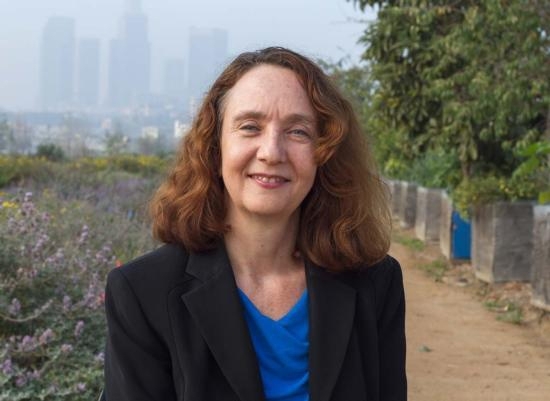
Citrus trees are favorites for Southern California backyards, but Surls and her team aim to get local gardeners thinking beyond lemons, limes, oranges and other citrus fruit. In the past several years, a deadly plant disease has been spreading among Southern California citrus, prompting quarantines and putting citrus orchards across the state at risk.
Surls and her team are working on an initiative with a corps of volunteer UC Master Gardeners in Los Angeles and surrounding counties to promote selection and planting of appropriate fruit trees. New brochures, a website, workshops and one-on-one consultations will guide Southern Californians in making tree decisions that are scientifically sound and community-focused.
The project addresses serious concerns about the rapid spread of huanglongbing (HLB) disease, also known as citrus greening. The insect that spreads HLB – the Asian citrus psyllid – was introduced into California in 2008. The disease made its first California appearance in a Los Angeles County backyard in 2012. HLB, which eventually kills every tree it infects, is now spreading rapidly in urban areas of Los Angeles and Orange counties, where quarantines have been put in place by the California Department of Food and Agriculture (CDFA).
“Citrus trees are so popular in Southern California. They are part of our history and regional identity,” Surls said. “Now we have the unfortunate responsibility of telling residents about this serious problem we are facing. In some cases, residents who live near infected trees should be proactive and remove their lemon, orange, mandarin and lime trees and replace them with different kinds of fruit.”
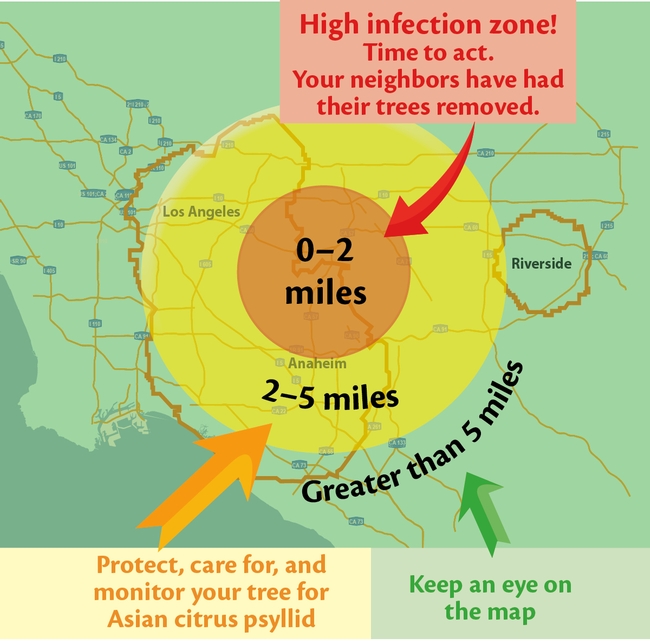
University of California Agriculture and Natural Resources IGIS programmers, in collaboration with UC Cooperative Extension, have created an HLB Monitoring Web App that allows residents to enter an address to determine how close they are to confirmed HLB outbreaks. If they are within 2 miles of a residence where an HLB-infected citrus tree was found, the app recommends replacement of citrus trees with non-citrus fruit trees, such as apples, peaches, avocados or persimmons.
Residents with citrus trees that are 2 to 5 miles from areas with HLB should keep a close eye on their trees, treat for Asian citrus psyllid and begin thinking about planting an alternative to citrus if the disease spreads to their area.
“Huanglongbing poses a serious threat to both backyard and commercial citrus in California if its spread is not halted,” Surls said. “By removing trees in areas where HLB has been found, residents are helping reduce its ability to spread, buying time for scientists to find a cure.”
CDFA is testing trees throughout the state and removing HLB-infected trees. However, the first visible symptoms of HLB – yellow mottled leaves – can appear months to years after infection. Even if they look perfectly healthy, citrus trees can be harboring the disease and allowing it to be spread by the tiny psyllid insect.
Current hotspots shown on the HLB Monitoring Web App include Rosemead, Montebello, Pico Rivera, San Gabriel, Hacienda Heights and Cerritos in Los Angeles County. In Orange County, HLB is spreading in communities around Garden Grove, Westminster and Santa Ana.
“We know removing citrus trees is going to be really hard for people,” Surls said. “But if you live within two miles of an infected tree, your tree is probably already infected, and HLB means your tree is going to die.”
To ease the transition, UC Master Gardeners are informing residents about alternatives that will produce fruit that's nutritious and delicious.
“So many types of fruit trees can be grown in Southern California,” Surls said. “Honestly, we have almost unlimited options. We live in a fruit tree grower's paradise. So we want to encourage local residents to think seriously about selecting non-citrus trees to replace their citrus.”
The information can also inform residents who are planning a new backyard orchard.
“They should consider some of the many wonderful fruit trees we can grow here — plant a pomegranate, plant a peach, plant a persimmon — but resist the temptation to plant more lemons, oranges and other citrus trees,” Surls said.
Making the decision to plant a certain type of tree should not be taken lightly.
“Planting a fruit tree is a big commitment. It will be part of your garden for years. Research the best options for your family and locations,” Surls said. “The UC Master Gardeners are here to help.”
Following are good options to consider for replacing citrus trees in Southern California, although recommendations may vary based on local climate:
Apples
Certain apple varieties that do not need to be exposed to cold temperatures grow and produce well in Southern California. Low-chill varieties include Anna, Beverly Hills, Dorset Golden, Fuji and Gala.
Figs
Figs grow well in full sun in Southern California. They can reach 10 to 30 feet tall, and are best for spacious areas.
Jujube
Jujubes are less common in Southern California, but are a valued fruit in Southeast Asian and will grow well under Southern California conditions. They grow about 15 feet tall. Jujubes are a good selection for inland valleys that get hot during the summer. The fruit tastes like small, crispy apples. Dried, they are similar to dates.
Loquat
A small- to medium-size tree that grows 10 to 20 feet high, loquats are easy to grow and have relatively few pests. Fresh, ripe loquats are sweet and aromatic. They can be used in jams, sauces and garnishes.
Persimmon
Persimmons ripen in autumn after the leaves have fallen, creating a beautiful landscape display. They are easy to grow in full sun and part shade. Persimmons can be eaten fresh or dried for a date-like fruit.
Pomegranate
Well-suited to Southern California's Mediterranean climate, pomegranates grow to about 15 feet in height. Pomegranates are pest- and disease-resistant. The fruit's seeds, coated with astringent juicy flesh, are called arils. Use arils to top salads or other dishes, or squeeze for juice or to make jelly.
Other fruit tree options for Southern California include mangos, guavas, pineapple guavas, peaches, nectarines and pears.
For more research-based information about alternative fruit trees, visit the UC Agriculture and Natural Resources website “California Backyard Orchard” at http://homeorchard.ucanr.edu.
Contact your local UC Master Gardener Program for additional advice:
Los Angeles County – http://celosangeles.ucanr.edu/UC_Master_Gardener_Program
Orange County – http://mgorange.ucanr.edu
Riverside County – https://ucanr.edu/sites/RiversideMG
San Bernardino County – http://mgsb.ucanr.edu
Ventura County – https://ucanr.edu/sites/VCMG
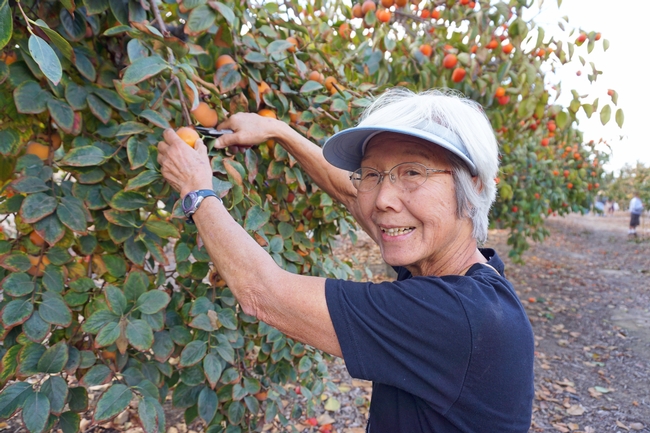
Funding for the ‘Alternatives to Citrus Fruit in the Fight against Huanglongbing Disease' project was made possible by the U.S. Department of Agriculture's (USDA) Agricultural Marketing Service through grant AM180100XXXXG003. Its contents are solely the responsibility of the authors and do not necessarily represent the official views of the USDA.
New book traces Los Angeles’ transformation from cows to concrete

“We now have food deserts over what was once abundant farmland,” said Rachel Surls, UC Cooperative Extension sustainable food systems advisor. “Although Los Angeles is not unique in this regard, there's something disconcerting about the speed and scale at which Los Angeles lost its ability to produce food.”
The dramatic conversions of Los Angeles are traced and explained in a new book by Surls and Los Angeles farm and garden authority and UC Master Gardener volunteer Judith Gerber. From Cows to Concrete: The Rise and Fall of Farming in Los Angeles, published by Angel City Press, is available on the publisher's website and from other booksellers.
Though hard to imagine when trapped in a traffic jam on the Santa Ana Freeway, under the pavement, parking lots and buildings are acres of once-productive farmland. Los Angeles County, with more than 10 million residents, now houses a quarter of California's population. But in the first half of the 20th century, Los Angeles was the top farm county in the United States.
In her role with UCCE, Surls works to encourage the newly active school, home, community and urban agricultural community in Los Angeles. She was intrigued to discover that the county now best known for Hollywood, high-rises, and luxurious homes, as well as grinding poverty and homelessness, was once a bucolic farming community. The knowledge sparked research that resulted in her seven-year collaboration with Gerber on the book.

Spanish land grants spawned vast ranchos in colonial Los Angeles that ran thousands of cattle and grew rice, corn, beans, melons and other fruit and vegetables. When Mexico won its independence from Spain, the missions' power declined and the rancheros gained influence. Many communities in Southern California bear the early ranchos' names, such as San Pedro, La Puente and Los Cerritos.
A series of developments led to Los Angeles County's designation as the No. 1 ag country in the nation by 1909. Among them were:
- Successful grape production that was started by the missions to make sacramental wine.
- A casual experiment by a grape farmer to plant orange trees, which exploded into a citrus growing empire.
- The arrival of the Southern Pacific railroad expanded the market for LA's perishable produce.
- The LA Chamber of Commerce led a transition of farming into an organized, sophisticated industry.
- The discovery of local oil provided affordable fuel to expand production of canned fruits and vegetables, and made irrigation with groundwater possible for more farmers.
Growth of marketing cooperatives, ag research by UC Cooperative Extension, and irrigation and market infrastructure would allow Los Angeles to hold its position as the nation's top farm county for four decades. Los Angeles led the nation in production of walnuts, lemons, strawberries, cauliflower, cabbage, lettuce, tomatoes, corn and hay.

But agriculture has not disappeared, say the authors of From Cows to Concrete. There are small pockets of agricultural land in the urban landscape, such as Richland Farms in Compton, where many people have large lots and keep horses and livestock. The new farm-to-fork movement is prompting families to cultivate vegetables in their backyards and community groups to find vacant space to produce food. LA allows residents to keep honey bees and some residents are raising backyard chickens.
“In a place where poverty is entrenched, with fruits and vegetables neither affordable nor accessible, why not use backyards, vacant lots, and other open spaces to grow healthy food, right in the neighborhoods that need them,” the authors ask. “The story of agriculture in California and Los Angeles is still unfolding.”
6 ways local officials can encourage urban farming
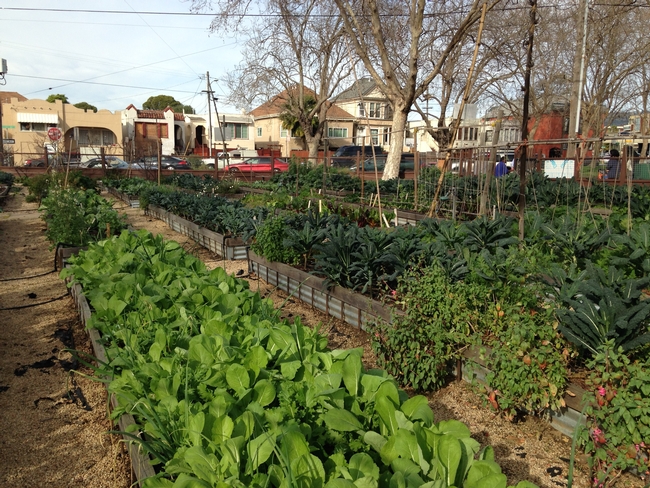
To find out how to help people who want to grow food in their communities in California, Rachel Surls, a UC Agriculture and Natural Resources Cooperative Extension advisor, and several UC ANR colleagues interviewed urban farmers as part of a statewide study of urban agriculture needs.
Surls, who specializes in sustainable food systems in Los Angeles County, and her colleagues identified several common challenges that UC ANR and local governments could address to cultivate a more urban agriculture-friendly environment.
In an op-ed published March 24 in the Sacramento Bee, Surls listed the following six things that local officials could do to encourage urban farming:
- Make zoning and regulatory information accessible
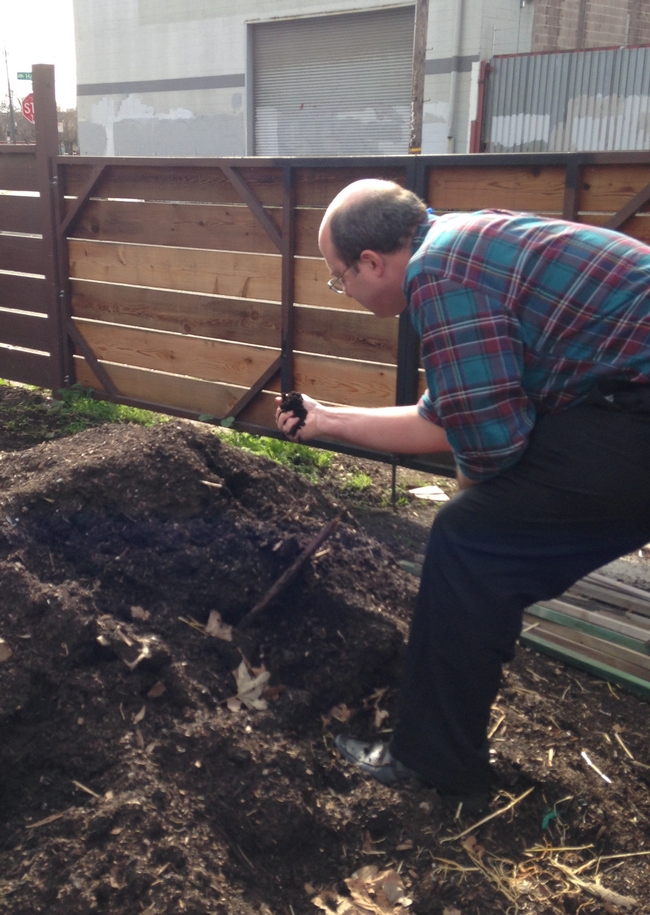 Rob Bennaton, UC Cooperative Extension advisor, helps urban farmers test soil in Alameda County.
Rob Bennaton, UC Cooperative Extension advisor, helps urban farmers test soil in Alameda County. - Develop a transparent process for use of city-owned land
- Create an urban agriculture incentive zone
- Update zoning to make it urban-ag friendly
- Make water accessible while promoting efficient use
- Provide guidance and support for soil testing and remediation.
There seems to be growing interest in cities encouraging urban farming. For example, last year Oakland updated its city codes to allow planting of community gardens in most zones of the city without obtaining a special permit. San Diego has made it easier for residents to keep chickens and bees in their backyards. The Sacramento City Council recently voted to allow residents to farm on urban lots and sell produce they grow at farm stands. And now, Santa Clara County is considering tax breaks for property owners who allow crops to be planted on their unused parcels.
Urban farmers told the researchers that UC ANR could help by providing educational materials on topics such as pest management, water management, design of community urban agriculture projects and soil testing and remediation.
To begin providing the public with information about urban agriculture, UC ANR has created a website at http://ucanr.edu/urbanag. Visitors to the website will find science-based information on raising crops and livestock, selling farm products and links to policies for farming in a backyard, at a school or a community garden.
“Many urban farmers are beginning farmers so the website offers basic information on planting, pests and irrigation, and on navigating local laws and regulations that impact farming,” said Surls. “But the website is also intended to be a resource for policymakers who are making decisions that impact local farming in their cities.”
For the latest information about urban farming, visit http://ucanr.edu/urbanag and follow @UCurbanag on Twitter.
The University of California Global Food Initiative aims to put the world on a path to sustainably and nutritiously feed itself. By building on existing efforts and creating new collaborations among UC's 10 campuses, affiliated national laboratories and the Division of Agriculture and Natural Resources, the initiative will develop and export solutions for food security, health and sustainability throughout California, the United States and the world.
Urban farms can help feed the hungry
(The Sacramento Bee published an op-ed by Rachel Surls, UC ANR urban agriculture advisor for Cooperative Extension in Los Angeles County, in its editorial pages today. The op-ed is reprinted below.)

In similar discussions around the state on the desire of residents to raise their own food with fewer restrictions, there is a core issue that should be front and center. In California, where we grow half of the country's fruits and vegetables, our own citizens too often go hungry.
Fifteen percent of households – roughly 5.5 million Californians – are “food insecure,” according to a 2013 federal report, meaning they do not have “consistent access throughout the year to adequate food for healthy active living.” Families with children are even more likely to run short on food.
We know that eating plenty of fruits and vegetables is key to a healthy diet, but not everyone has ready access to a grocery store, or can afford to buy fresh produce. One potential solution is to make it easier to grow food in backyards and on vacant land.
The University of California's Global Food Initiative aims to help the world sustainably and nutritiously feed itself. One way that UC Agriculture and Natural Resources is working toward that goal is by providing information for urban farmers and decision-makers interested in urban agriculture to improve food security in their communities. While hunger and food security are complex issues, urban farming can be used with other strategies to help ensure access to affordable, nutritious food.
And the idea seems to resonate with Californians. Interest in urban food production can be seen around California. Following strong advocacy efforts at the grassroots level, Assembly Bill 551 was passed in 2013, allowing local governments to designate urban agriculture incentive zones. San Francisco has enacted the state's first one.
Several other cities have developed local policies to promote urban agriculture. San Diego, for example, has made it easier for residents to keep chickens and bees in their backyards, and to establish farmers markets, produce stands, community gardens and small urban farms. Oakland updated its city code in 2014 to allow community gardens in most of the city without a special permit.
But obstacles to urban agriculture remain in many cities, including land use restrictions, difficulty accessing water, soil contamination and a lack of information on local regulations. After conducting a statewide study, my colleagues and I found a number of common challenges and came up with six steps that local officials can take to break down common barriers.
They are: Make zoning and regulatory information accessible; develop a transparent process for using city-owned land; create an urban agriculture incentive zone; update zoning to make it urban-ag-friendly; make water accessible while promoting efficient use; and provide guidance and support for soil testing and remediation.
An easy way to let urban farmers know what is allowed is to post information on a website, as San Francisco has done. Through AB 551, cities can entice property owners to lease their land for gardens and farms in exchange for reduced property taxes. Cities can also partner with urban farmers and local food policy councils to identify concerns and ways to address them.
In addition to health benefits, urban gardens beautify the community and provide common ground for people of different ages and cultures to work together. They can also create jobs, learning opportunities and economic savings on food. Given the numerous potential benefits, local officials can better serve their communities by making it easier to cultivate food locally.

